| This new page is currently undergoing modifications. The information presented should be considered a draft, not yet ready for use. Content is being prepared by one or more users. Do not make any changes before you post a message in this forum. |
If you were advised to read this wiki article, it means another editor believes some of your map edits using the Waze Map Editor (WME) are not following our overall guidelines. Those edits may already have been modified or deleted. This may be an unpleasant surprise, especially if you put a lot of time and energy into those edits, but rest assured that you are in good company. Every one of Waze's many volunteer editors has made mistakes that required correction or removal.
The purpose of this article is to help you understand what about your edits may have needed attention and to offer you suggestions on where your editing energy could do the most good.
Incorrect edits are a natural part of Waze
Having edits undone or redone may make you feel like being a Waze editor is not for you. That's a reasonable response, but actually, both Waze and the volunteer editing community need you.
It is very important to Waze to encourage new editors and they believe that omitting any training requirements to get started is a better path to increase the number of editors on the map. Without any information, practice, or tests -- in fact within minutes of discovering Waze -- you can begin modifying Waze's maps. This is exciting, but it also means you will make mistakes. We all do.
Incorrect edits are a natural part of Waze. So please don't feel bad! Because these maps are used by your friends, neighbors, and more than 50 million other people, your fellow editors must act as soon as they discover the map is not how it should be.
Incorrect edits include both functional mistakes and misunderstood conventions. Functional mistakes are more serious, but both require response.
Common functional mistakes
A functional error introduces wrong or incomplete data or faulty routing. Functional errors must be addressed as soon as they are detected. If your incorrect edit was a functional mistake, the editor who discovered it has probably already taken steps to fix it.
Red roads
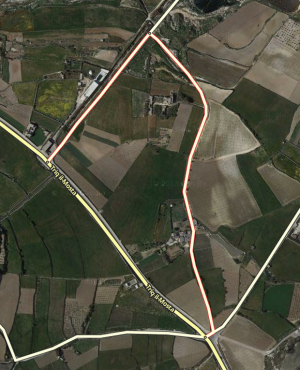
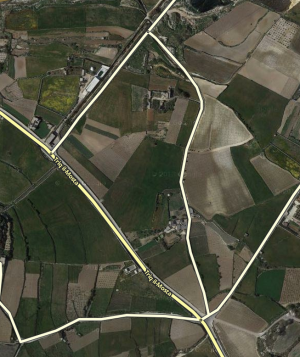
- For more details on this topic, see Creating and editing road segments.
Mistake: Roads that appear bright red in the WME were published before all necessary parameters were set properly. Unfinished roads and roads created with the Waze client's pave feature will lack these parameters. These roads may appear on the Waze client but are useless for routing. Their prominent display in the editor calls attention to incomplete edits.
Response: Do not automatically delete red roads! The road may show up as such because a user added a missing road by driving it with the pave feature enabled, or because a local editor with first-hand knowledge created it in the editor but did not confirm its details. These roads may reflect construction that occurred since the satellite and/or street-view imagery was acquired.
If the red road appears to indicate a drivable road that will improve routing to adjacent destinations, complete it as necessary and verify turn restrictions. Try to preserve the creator's name out of respect for their having found the omission and attempted to remedy it.
If the red road is clearly spurious, or if finishing it would disrupt routing as in the common case of unnecessary parking-lot roads, private alleys or driveways, delete it.
Misplaced roundabouts
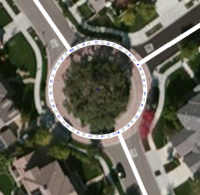
- For more details on this topic, see Roundabouts.
Mistake: The WME Roundabout tool creates an intersection that gives roundabout-specific routing instructions to drivers, such as "at the roundabout, take the third exit" (for roundabouts at complex intersections) or "turn left at the roundabout" (for roundabouts at simple perpendicular intersections). If those routing instructions could confuse drivers, the Roundabout tool should not be used. Roundabouts do not belong at cul-de-sacs or other dead ends, regardless of how round they are. Neither do they belong at traffic calming circles without roundabout signs, at decorative turns, or at circular entrance driveways. Depending on circumstances, they may be inappropriate for large traffic circles, especially those with street names of their own and stop signs or lights controlling access.
Response: If the satellite image leaves doubt, use Street View to verify that no signs suggestive of a roundabout are present. If it is a roundabout, ensure the layout matches the desired roundabout routing behavior, either orthogonal or odd-angle. If it is not a roundabout, delete it and replace or repair any associated connections.
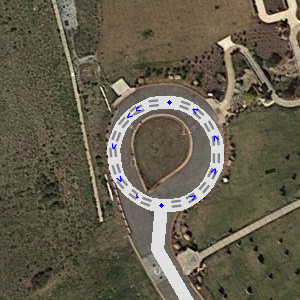
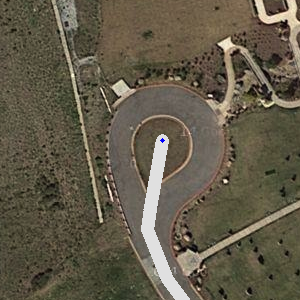
Overlapping segments
Mistake: Except in the case of at-grade connectors, there should be only one segment routing traffic along any given street. Overlapping segments wreak havoc with the routing and house-numbering systems.
Sometimes editors create overlapping segments because they don't know how to modify the existing segment, or find it is locked above their editing rank. The correct approach is to seek help, not to add a new segment on top of an existing one.
Response: Identify the overlapping segment -- typically the one without house numbering and/or with improper connections to other nearby segments -- and delete it. Repair turn permissions.
Disconnected/disjoint segments
Mistake: Just because segments appear to intersect doesn't mean they really do. A proper intersection will display all turn restrictions if any connecting segment is selected. A segment that only appears to connect will not only fail to route but will also confuse editors trying to understand the failure.
Response: If the intersection appears valid and the segment is correct, routable, and complies with conventions, connect the segment and set turn restrictions appropriately. If the intersection is not valid but the segments are correct, space them so it will be obvious to other editors that they do not connect, and consider locking them to be sure they stay that way. Otherwise delete the segment.
Corrupted turn restrictions
Mistake: Sometimes when modifying an intersection an editor will, through accident or lack of awareness, leave important turn restrictions red. This will prevent routing on the affected segments. In the worst cases significant roads may effectively be closed to Wazers, who are instead detoured through adjacent neighborhoods.
Response: Correct the turn restrictions as soon as possible.
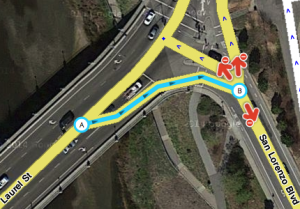
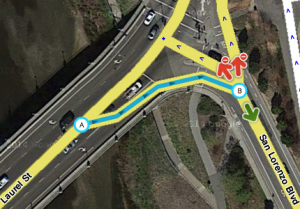
Critical segments missing
Mistake: It should go without saying that a road will not route if it does not go through, but it happens that editors delete or leave out critical segments.
Response: Replace the missing segments and verify turn restrictions as soon as possible.
Failed editing due to locked segments
Mistake: It is impossible for entry-level editors to attach new segments to a locked road, although they can and do try, leading to disconnected/disjoint segments as described above. Worse, the new editor may assume that they did indeed correct the problem, and leave the area broken until someone else stumbles across it.
Response: Contact an editor of the required rank to fix the area. There are three typical ways to do this:
- Broadcast a request for help in the Waze Map Editor Chat. Be sure to specify the rank you need and the location involved. Not all editors monitoring the chat will have the necessary rank and editable area to help you.
- Submit an "unlock/update request" to the Community Forums. This post describes the general procedure but is not country-specific. Many countries have their own unlock/update forums; it's important to post in the correct one and use the correct protocol!
- Send a Private Message (PM) via the forums to the editor whose name is marked as having last modified the locked segment. This does not always work but is worth trying especially if the first two approaches don't seem to be getting you anywhere.
Excess or misaligned geometry nodes
- For more details on this topic, see Creating and editing road segments#Editing existing roads.
Mistake: Excess geometry nodes slow the display and make a segment harder to edit, while misaligned nodes affect display aesthetics and in extreme cases disrupt Waze's ability to determine what road a driver is on.
Response: Remove excess geometry nodes (using mouse-hover and the 'd' key) and correct misaligned nodes.
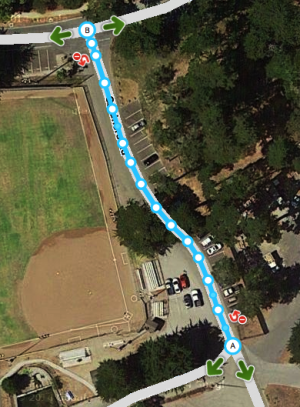
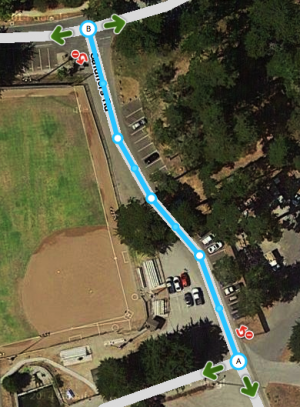
Misunderstanding the "Highway" road type
Mistake: It is counterintuitive, but in Waze, "highway" does not necessarily mean a road that carries a lot of traffic. It just means a road that carries more traffic than nearby alternatives. For example, a barely-maintained one-lane mountain road may be a "Minor Highway", and a two-lane street serving a small village a "Major Highway". Assessing a road by its significance relative to nearby alternatives is called "functional classification" or FC.
Such situations often baffle new editors to whom this application of the word "highway" seems absurd. As a result, some will attempt to "put it right" by lowering Highways to Streets or Primary Streets, unwittingly ruining the careful and methodical work that was required to set the road type according to national FC standards.
Response: Find the government FC map for the affected area and restore the Waze road classifications according to editing-community conventions. Consider locking the affected segments, especially if local convention recommends it.
Unnecessary road splitting
Mistake: Just because a road is divided by a median strip in reality is not enough reason to split it in Waze! Splitting roads can cause a great deal of trouble and should not be attempted without care and preparation. Always check with the local Area Manager before splitting a road and follow best map-editing practice.
Response: Check with the local Area Manager or a Champ. Unsplitting roads can cause as many headaches as splitting them in the first place. Do not automatically assume that a newly-split road is incorrect, even if the split was performed poorly or by a novice editor.
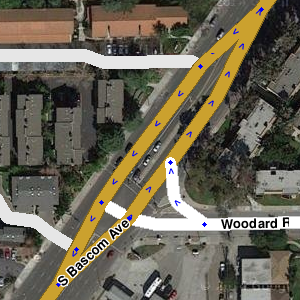
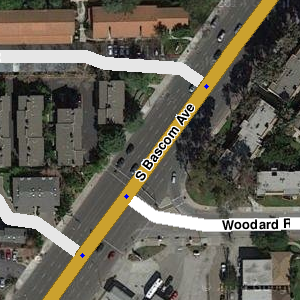
Unnecessary and/or connected walking paths
Mistake: Walking paths are not benign! Waze will route drivers over them! Even when not connected to the drivable road network, walking paths that come too close to drivable destinations can corrupt routing results.
In addition to their potential effects on routing, mapped walking paths may encourage people to use Waze while walking or bicycling, a practice that can pollute Waze's traffic-detection data. Editors should not create walking paths for the sole purpose of supporting people using Waze while walking or bicycling. That includes adding segments to respond to automated Map Problem reports (usually of type "missing road") generated as a consequence of people Wazing while walking or bicycling.
Very few circumstances call for the mapping of walking paths.
Response: First of all, unless this is one of a tiny handful of cases where a walking path is required to reach a routable destination, disconnect the path from any drivable road segments. If there is any chance the walking path could confuse drivers or distort local routing, delete it, but be sure it was not deliberately placed to fix poor routing to a large region such as a park.
If the path is sufficiently isolated so as not to cause routing problems and it is named (e.g. "Los Gatos Creek Trl"), consider leaving it, particularly near any parking for the path, as its name may be used as a search term. Also consider leaving walking paths used by Wazers that have long parallel stretches alongside roads; if we can't stop people from using Waze while walking or biking, we may as well reduce the likelihood they will corrupt the speed data for adjacent traffic.
Unnamed walking paths that do not get used by Wazers and are not required to reach a destination should be deleted even if they don't disrupt local routing. They may not appear to do any harm, but their presence encourages other editors to add to the paths or create new ones.
Access roads that distort routing
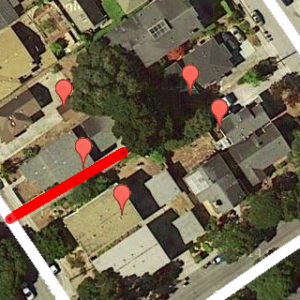
Mistake: New editors often believe that if you can drive it, you can map it, and commonly add parking-lot roads, driveways, and private alleys because they are there. Such roads can distort rather than enhance routing! When using Google for position data, Waze attempts to route drivers on whatever road will get them closest to the destination coordinates; thus unnecessary roads can have unintended routing consequences. For example, if you add a private road to your house as in the figure, Wazers visiting your neighbors will find themselves routed up your driveway.
Unnecessary roads can also cause routing distortions when departing a destination. This results from Waze's attempt to "snap" the driver to the nearest available road before determining a route. If you add a private alley that connects two streets through a warehouse district, for example, a delivery person nearer to the alley than the street may be snapped incorrectly to the alley and given an impossible route to his next destination.
In general, you should map roads because they are necessary for routing and not simply because they are there. Please see the driveway guidelines for more information on best practice.
Response: If the road does not comply with the driveway guidelines, consider deleting it. If it appears to comply but causes routing issues that cannot be improved with additional compliant roads, that may call for deletion as well.
Unnecessary at-grade connectors
- For more details on this topic, see At-grade connectors.
Mistake: At-grade connectors are not necessary unless the driver needs advance warning of an upcoming turn. Unnecessary at-grade connectors are more trouble to analyze and maintain, and their close proximity to the through road from which they split can lead Waze to snap drivers to the wrong road. Asking for a route while snapped to the wrong road, for example while waiting at a stoplight too near an at-grade connector, will result in incorrect routing.
Response: Delete the unnecessary at-grade connector as well as any newly-unnecessary junction nodes that result, and modify turn restrictions to account for the new routing.
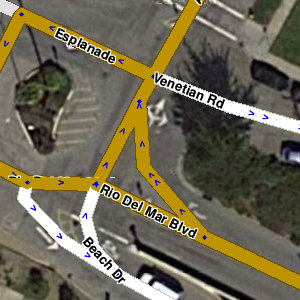
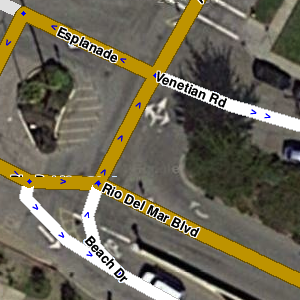
Misuse of the Ramp road type
Mistake: One seldom needs the Ramp road type unless editing around controlled-access highways or freeways. Entry-level editors often use Ramps in places they don't belong, particularly for at-grade connectors (AGC). The USA Ramp guidelines provide details on appropriate use of ramps.
Response: Change to the correct road type and rework if necessary, or delete if unnecessary. In the case of an AGC, check if the ramp is an allowed exception before changing it to another road type in accordance with the AGC road-type guidelines. Verify turn restrictions.
Commonly misunderstood conventions
Misunderstood conventions do not necessarily involve wrong data or faulty routing, but violate editing conventions agreed upon by the local Waze editing community. The damage done by a misunderstood convention is primarily by example; other editors will interpret the error as a model for what they should do, and the mistake will proliferate.
If you've been approached regarding misunderstood conventions, you may have been given the opportunity to correct or delete your work. Please do so! It may be the least enjoyable thing you will do in Waze, but if you don't do it, someone else eventually will, and in the meantime the incorrect example may influence other new editors.
Excessive use of Parking-Lot Roads

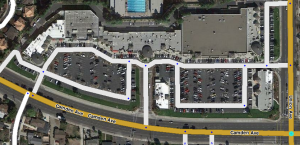
- For more details on this topic, see Parking Lots.
Misunderstood convention: While mapping every lane in a parking lot does not cause functional problems, it does create a busy appearance in the client display that is completely unnecessary for routing.
By convention the Waze editing community only maps the minimum number of parking-lot roads necessary to ensure proper routing to and from destinations. In many cases no parking-lot roads are necessary at all. In some cases adding parking-lot roads will disrupt local routing rather than improve it.
Response: Delete extraneous parking-lot roads and any newly-unnecessary junction nodes that result. Remember that parking-lot roads absorb slowdown detection, so be sure not to delete lanes that "protect" adjacent thoroughfares from spurious heavy-traffic warnings.
Misuse of Area Places


- For more details on this topic, see Places.
Misunderstood convention: Area Places (formerly known as Landmarks) appear on the client display as colored polygons, helping to orient the driver by indicating distinctive structures or open space. Current convention holds that Area Places should always be associated with "visual significance", locations that stand out from their surroundings because of their appearance or their size (an exception is made for locations considered potentially critical to drivers, such as gas stations, or hospital, police or other emergency services).
As a result, use of an Area Place to mark a location that does not stand out from its surroundings in any way detracts from the ability of other Area Places to serve their primary function. Such a location may not satisfy local editing conventions for Area Places and may wind up reworked by another editor. To make the Area-or-Point decision more objective, a large table specifies many Place categories that should always be marked with Point Places.
Controversy surrounds the Area Place. Some senior editors disagree with the current Place guidelines and recommend that editors be allowed greater flexibility in creating Area Places large and small; others argue that Point Places provide navigation and routing capabilities identical to those of Area Places and ask that Area Places be reserved only for critical or visually-significant locations. However things turn out, the safest approach for now is to abide by the current guidelines.
Response: In at least one region a very senior editor asks that all Area Places be left untouched. If you are editing in such a region simply leave all Area Places exactly as you found them even if they violate the wiki. In other regions a senior editor may wish to be informed before you significantly modify any Area Place.
If you are not editing in such a region, and if the Place would be correct and compliant as a Point Place, convert it to a Point Place and adjust its location for best routing. Otherwise, delete it.
Always, before removing or modifying an Area Place, take a moment to consider how much effort went into its creation. Do not modify a complex Area Place, even a non-compliant one, without first sending the author a link to this article via PM and allowing him or her considerable time, perhaps several weeks, to modify or remove it. In the rare case of disagreement, contact an area manager or local Champ.
Misuse of the Parking-Lot Area Place
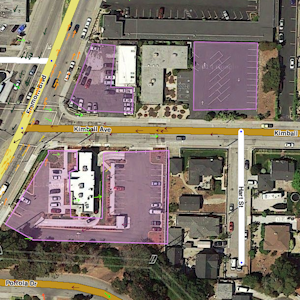
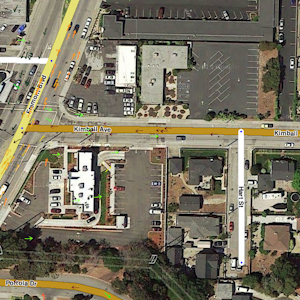
- For more details on this topic, see Places/Parking lot.
Misunderstood convention: The Waze Map Editor gives easy and prominent access to the Parking-Lot Area Place directly from the create menu. In most urban or suburban neighborhoods, however, mapping every parking lot would create a vast ocean of parking. To simplify the maps, the Waze editing community only uses the Parking-Lot Area Place for off-street general-purpose parking provided for the general public.
If you really did map general-purpose parking for the general public, the best way to reduce the chance it will be deleted is to assign the parking lot its documented name. Unnamed Parking-Lot Area Places are much more likely to be deleted.
Response: If the parking lot complies with guidelines, ensure that the Name field shows its documented name, e.g. "City Lot #6"; compliant lots with no name may be given one as long as it is somehow specific, e.g. "Redwood City public parking". If the lot has a name but is for private or dedicated use, you may consider converting it to a Point Place. Otherwise delete it.
As with Area Places in general, before removing or modifying a Parking-Lot Area Place, take a moment to consider how much effort went into its creation. Do not significantly alter a complex Parking Lot, even a non-compliant one, without first sending the author a link to this article via PM and allowing him or her considerable time, perhaps several weeks, to modify or remove it. In the rare case of disagreement, contact an area manager or local Champ.
Closing URs without proper consideration
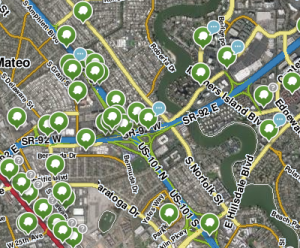
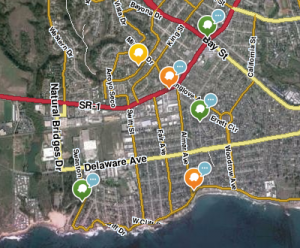
- For more details on this topic, see Update Requests in Waze Map Editor.
Misunderstood convention: Waze users file Update Requests (URs) to alert the editing community of problems they experienced. In some cases URs can indicate significant errors in the map, but drivers rarely have time to enter adequate text in the description field. They depend on the editing community to open a conversation with them so they can explain more fully what happened. Handling URs follows a careful process that (a) provides drivers with an adequate opportunity to explain their report and (b) provides editors with an adequate opportunity to work the report once they begin.
An editor who closes a UR without following this process commits a serious breach of Waze etiquette! Closing URs without due consideration confuses reporters who expected to have their concerns taken seriously and injures their good will towards Waze. Closing URs being actively worked may be even worse as doing so interrupts the communication, sends a mixed message to the reporter, and frustrates the efforts of the working editor.
Response: Once closed, a UR will remain accessible for several days. A skilled editor who catches the closure in time and moves quickly may be able to work a closed UR before it disappears. If a dialogue can be established with the reporter, it can be continued using the emailed links to the UR conversation even after the UR has disappeared from the map.
What should I edit, then?
Your energy is best focused on regions you know, but if you live and work in a heavily-populated area, your local neighborhoods may have been edited and re-edited many times. There may be little left to do aside from removing excess geometry nodes, correcting minor misalignments, and verifying turn restrictions.
Consider editing less-traveled locations you may have visited recently. Many non-industrial and rural communities have seen little attention since the original base-map import. Such regions often abound with misnamed roads, dirt roads misclassified as streets, improper turn restrictions and street directionality, roads shown as through that do not go through, and so on. Finding good information to correct these issues may take some work, especially in more remote areas, but it is a terrific contribution.
If you do choose to focus on a heavily-edited area, be aware that many have come before you. Things that don't seem right at first may have resulted from days or even weeks of careful adjustment. Exercise caution before modifying other editors' work.
Constructive work for new editors
- Verify road-name spelling and capitalization by checking against local government GIS as well as signage viewed in street-view imagery, and ensure name consistency within city boundaries.
- Verify that street-type suffix abbreviations (e.g. for Road, Drive, Avenue, etc.) are used and comply with abbreviation standards.
- Verify that street-type prefixes in cases such as "Avenue of the Flags" (and in the US, particularly Spanish street-type prefixes such as Calle, Paseo, Avenida, etc.) are not abbreviated unless that is local custom.
- Verify road directionality, particularly one-way roads that Waze may show as two-way.
- Verify turn restrictions, including timed turn restrictions.
- Correct streets shown as through on the Waze map but that are blocked in reality.
- Add recently-constructed roads not yet shown on the maps, or shown incorrectly due to obsolete satellite and street-view imagery.
- Correct road alignment errors and remove excess geometry nodes.
- Contribute suggestions to User-Request conversations already opened by other editors, particularly if you have local knowledge that could help resolve the issue.
- Alert area managers and/or senior editors to problems.
- Add or update name, city, and address data for existing Point or Area Places.
- Correct categories for existing Point or Area Places; in particular, when Waze rolled out Places, existing hotels were often assigned the category of "Hostel" instead of "Hotel".
- Add Point Places.
Risky work for new editors
- Adding non-drivable roads such as walking paths, railroads, runways and taxiways, etc. (they may not sound risky, but because of the way Waze implements these they are surprisingly likely to influence routing in the immediate area).
- Adding parking-lot roads (risk of overdoing it, of disrupting routing to nearby destinations, of leaving behind corrupted turn restrictions, or of failing to join the roads to adjacent locked segments).
- Adjusting major intersections, ramps, or highways (highly likely to encounter locked segments, but even if not, risk of disrupting heavily-traveled areas).
- Splitting or un-splitting roads.
- Working and closing user-submitted Update Requests (requires extensive familiarity with UR etiquette and with common problems encountered by Wazers).
- Editing inside Private Installations (tracking the routing penalties requires great care).
- Adding or modifying roundabouts.
- Adding Area Places.
Further reading
The Waze wiki offers a wealth of detail on all aspects of map editing. The following pages are good places to start. Be sure to also find and read the editing guidelines specific to your country.
- Map Editing Quick-start Guide
- Best map editing practice
- Map Editing Tips and Hints
- Waze Map Editor
- Editing manual
- Creating and editing road segments
- Road types and names
Besides the wiki, one may also ask questions and access current conversations on the Waze forum. Start by reading this post.